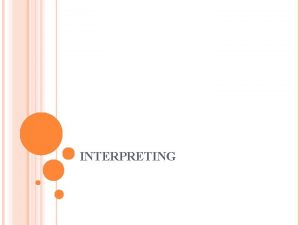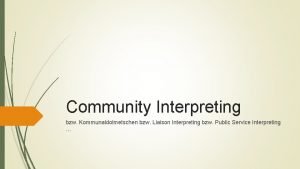INTERPRETING WHAT IS INTERPRETING It is transferring the









- Slides: 9

INTERPRETING

WHAT IS INTERPRETING ? It is transferring the meaning from a language (Source Language) to another (Target Language). “Interpreting is the transfer of one spoken or signed language to another. Interpreters work in a wide range of different settings – from international conferences and business meetings to courts and doctors’ surgeries. ”

TYPES OF INTERPRETING On-Sight Simultaneous Consecutive Bilateral

ON-SIGHT An interpreter is given a written document in one language and asked to read it out loud in another language. It involves reading comprehension, scanning for main ideas, fast reading, analysis of language, vocabulary enrichment and comprehension verification through paraphrasing.

SIMULTANEOUS Most effective for large meetings and conferences. Requires specialized equipment: all contributions are relayed by microphone to the team of interpreters working from soundproof booths within the room – their interpretation is then transmitted back to the delegates through individual headsets. It is recommended for large meetings, especially those with more than two languages.

CONSECUTIVE Most efficient at meetings and presentations with a small audience. During Consecutive Interpreting the speaker stops every 1– 5 minutes (usually at the end of every “paragraph” or complete thought) and the interpreter then steps in to render what was said into the target language. A key skill involved in consecutive interpreting is note-taking, since few people can memorize a full paragraph in one hearing without loss of detail. Samples of situations when consecutive interpreting is used are question and answer sessions, presentations, press conferences, speeches, court hearings, conference calls and interviews.

BILATERAL This type of interpreting is often used for interpreting in the community, at the request of doctors, lawyers, hospitals, social services and schools. It can also be used over the phone for telephone interpreting. The interpreters are required to interpret for one or two delegates in a variety of settings ranging from business and diplomatic gatherings to factory visits. The Interpreter does not work in a booth.

GENERAL SKILLS NEEDED Knowledge of the general subject and technical field of the material to be interpreted. Intimate familiarity with both cultures. Solid general education and extensive vocabulary in both languages. Ability to express thoughts clearly and concisely in both languages. Excellent note-taking techniques.

TRANSLATING V. INTERPRETING https: //www. youtube. com/watch? v=jhqm. GFKk. J_E&feat ure=youtu. be
 How do waves transfer energy without transferring matter
How do waves transfer energy without transferring matter A wave transfers
A wave transfers Example of group transferring coenzyme is
Example of group transferring coenzyme is You may injure your back if you lift
You may injure your back if you lift Unit 16 the patient's mobility transfer skills
Unit 16 the patient's mobility transfer skills Chapter 11 admitting transferring and discharging
Chapter 11 admitting transferring and discharging Ca tlr transfer
Ca tlr transfer Consider transferring an enormous file of l
Consider transferring an enormous file of l Chapter 19 safely transferring the person
Chapter 19 safely transferring the person Secondary storage vs primary storage
Secondary storage vs primary storage

















